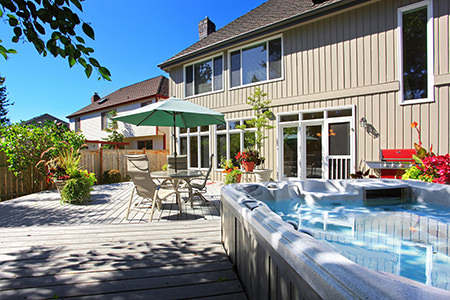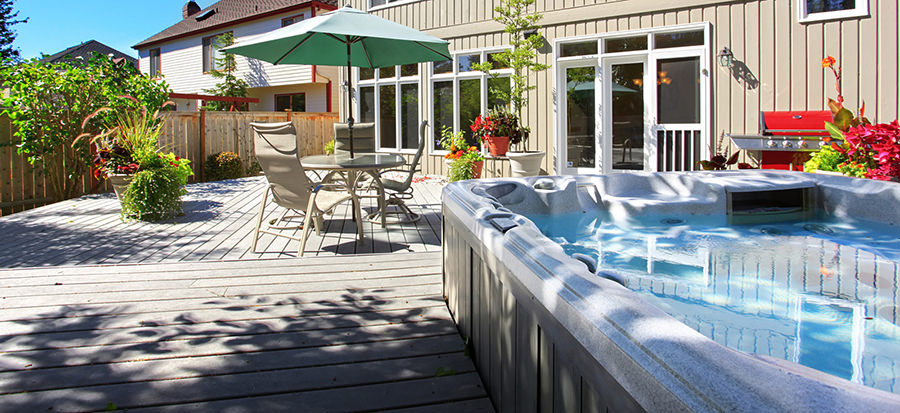
Installing a hot tub into your home or garden is a big step and takes some forward planning and a bit of know-how to get right. However, hot tub installation, once you know what you are doing, is relatively straight forward and, with the help of this guide you can look forward to a hassle-free installation as well as many years of happy soaking in your hot tub.
How to install a hot tub. A hot tub needs to be installed on a firm and level base with access to an electricity supply and water. Generally speaking, you don’t need planning permission to install a hot tub. After preparing the base, check the route the hot tub will have to take to get to the base to make sure there are no obstructions. Once the hot tub is safely installed on the base call in an electrician to make the electrical connection. Fill the hot tub and enjoy!
So, that’s it in a nutshell but there are a number of things that can go wrong along the way and potentially cause a lot of inconvenience and expense too. Let’s have a detailed, step by step look at what you need to do:
Choosing the best location for your hot tub
Your first decision is going to have to be exactly where you are going to put your hot tub. This will be determined by the size of your house/garden, the prevailing weather, your electrical and water supplies etc etc etc.
Inside or outside – There are a number of pros and cons to having your hot tub inside or outside but your decision will probably be mainly dictated by space. If you do have the space for an inside hot tub then you might be attracted by the prospect of all year round hot-tubbing in a nice, cozy environment with all of the privacy and convenience that comes with it. However, there are a number of practicalities that you will need to consider:
Ventilation – If you have an indoor hot tub you will need to carefully consider the ventilation in the room. A hot tub gives off a lot of moist and chemically-laden vapor which will cause a lot of damage to the decorations and potentially to the structure of the room if they are not allowed to escape. Moisture will collect on walls leading to damp, mold and mildew and could eventually penetrate the walls themselves. You will also need to make sure that there is a sealed door between the room containing the hot tub and the rest of the house to prevent moist air leaking through.
The floor – A hot tub is extremely heavy, especially when full of water and bathers and you will need to stand it on a solid floor. You simply cannot stand a hot tub on a suspended wooden floor without either significant reinforcement or the addition of a brick/concrete plinth to take the weight. If you are intending doing structural changes to the floor of the room it would be a good idea to consult with a surveyor/engineer beforehand to make sure that your plans are safe and possible.
Getting rid of water – Whilst thinking about the floor, bear in mind that you will inevitably create splashes of water on the floor and you need to be sure that water on the floor won’t damage the floor or create a dangerous slip hazard. You will also need to bear in mind that the hot tub will need periodically draining. Make sure that it is possible to attach a drain hose to your hot tub or invest in a sump pump so that you can direct the drained out water to where you want it to go. A lot of hot tubs simply have a drain plug which by default drains onto the ground. Obviously indoors this will not be practical!
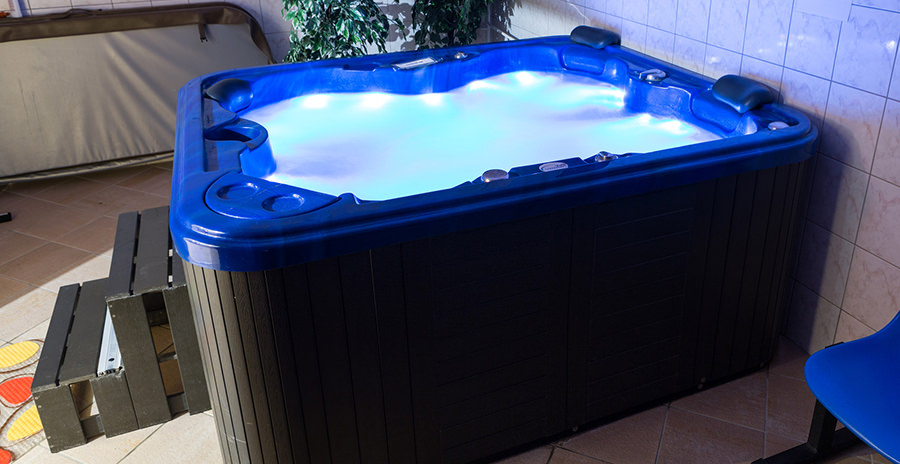
Installing an indoor hot tub – The other consideration that might make installing a hot tub indoors a bit tricky is the fact that the hot tub will have to be lifted inside through the doors. Will it fit through your doors? Will you have to remove some windows to get it in? Will you install the hot tub and then build around it? If so, what happens if you want to remove the hot tub at a later date?
So, having an indoor hot tub does seem to come with a few more practical considerations than having one outdoors but it would be perfectly possible to have one in a conservatory or similar room and without too many problems. You can find more details about planning for an indoor hot tub in my post here.
If you decide to go for an outdoor hot there are a number of similar considerations as well as a few extra ones!
Hot tubs and the weather – First of all, consider the weather in your location. Do you want your hot tub to be in full sun whilst you use it or would it simply be too hot and would a shady area would be better? Think also about the prevailing wind. You don’t want your hot tub to be in an open draughty area, it will make it colder when you use it and also make a difference to the energy consumption of the hot tub as well. Ideally, you want a nice sheltered and cozy spot probably in one of the warmest spots in the garden
Hot tub accessibility – Also, have a think about how you will access the hot tub. There’s no point in installing it in a beautiful spot in the garden that’s a five-minute walk away from the house. You simply will not want to get into it as frequently and the distance from the house will make it more inhospitable and remote. Ideally, you want to be close to the house so that getting in and out and getting changed is seamless and easy.
Hot tub privacy – Also consider your privacy. You need a spot that isn’t overlooked by your neighbors and where you will feel comfortable in your swimming costume. Consider the likely noise issues for your neighbors as well, you don’t want to start getting noise complaints from them and you also don’t want to be having your conversations in the hot tub overheard either.
So, this all seems like rather a tall order! You need a spot that’s not too far from the house, not too near to your neighbors, in a sheltered part of the garden and close to the facilities below as well! In reality, you will probably not have the absolute perfect spot. As in many things in life you might well have to compromise a little. Just spend the time thinking and planning before you get the hot tub as, once it’s installed, it’s going to be a real headache to move it!
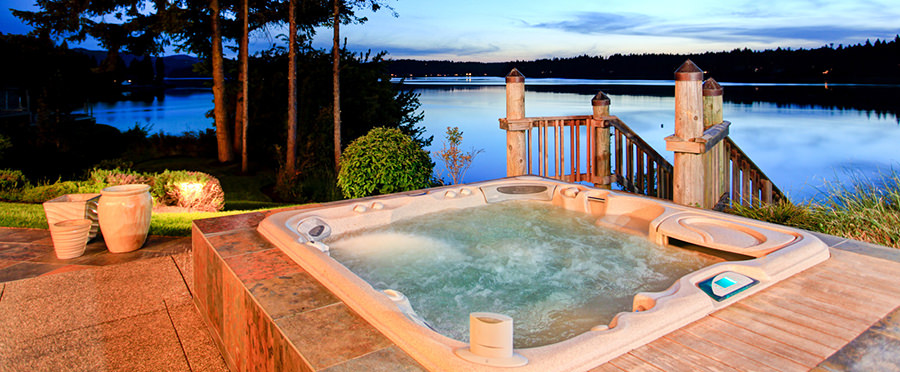
What sort of base do you need for a hot tub?
Having the right base for your hot tub is vitally important as, without the correct support your hot tub may move or the structure may become damaged. A full hot tub is extremely heavy and the frame has to support the shell evenly or there is a risk of the shell being put under excessive strain and cracking. The base has to be perfectly level and solid to give the correct support. There are a number of options to consider:
Concrete hot tub bases – Pouring your own concrete base is a perfectly reasonable option for a DIY job and, as long as you research it properly shouldn’t present too many problems. The slab needs to be at least 4 inches thick, have steel reinforcement and also have a good subgrade bed beneath it which must be perfectly level.
You would begin by excavating a hole the size and shape of the hot tub footprint with at least a foot or two of extra around the edges. The sides are then lined with wooden planking to the height that you want the final base to be. The bottom of the hole needs to be as level as possible and is then filled with hardcore and topped with coarse gravel. Again, this needs to be compacted and completely level before the steel reinforcement is added and the concrete poured. It’s not exactly rocket science but involves quite a lot of manual labor and careful leveling.
Patios or terraces – You might well already have a patio or terrace in the garden where you could stand a hot tub. If so, you need to be sure that the slabs are laid on hardcore or solid foundation. Loose slabs or patio slabs that have just been laid on sand may not have the inherent strength to support a full hot tub without moving. You may need to dig out a section of the terrace, fill it with hardcore and relay the slabs on cement to make a strong enough foundation. Once complete this wouldn’t look any different from the rest of the patio but would be significantly stronger.
Hot tubs on decking – An unmodified deck simply is not strong enough to support a hot tub. If you want to have your hot tub on a deck you will need to add significant bracing underneath and consult an engineer to help you work out exactly how to do it and to make it safe.
A far better plan is to build a brickwork plinth to raise the hot tub up to the level of the deck and then to add decking around that. The hot tub’s weight is then supported on the bricks and mortar of the plinth rather than by the floating wooden deck. If you already have a deck this might mean some fairly major work in terms of cutting a hole in the deck for the plinth to be built beneath and making sure that it is exactly the right size and level for the hot tub. In many ways, it would be much simpler to build the plinth first and position the hot tub before adding the deck afterward. Whichever way you decide to do it, careful measuring and leveling will be needed to make sure that the height of the hot tub and the raised deck end up being exactly the same.
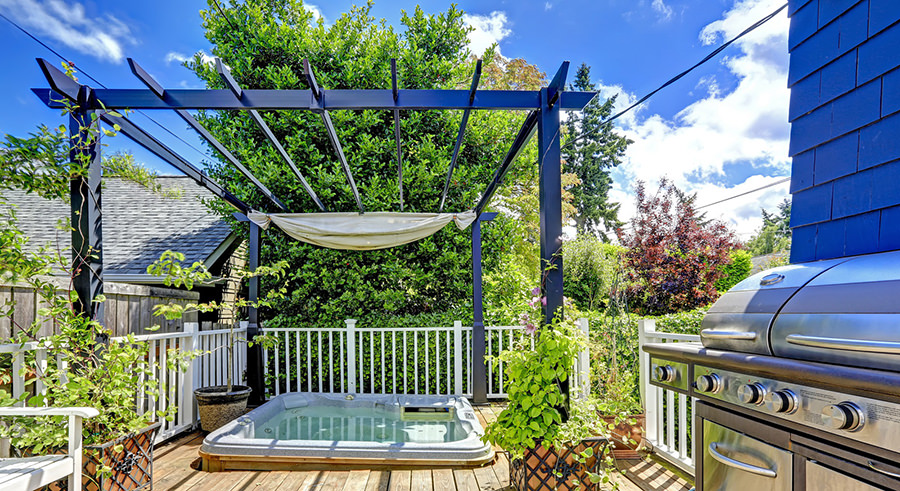
Hot tubs and grass – It’s not possible to put a hot tub on the lawn or straight onto the earth. It will gradually sink and damage the hot tub. However, you can use hot tub pads. These are inter-lockable plastic slabs that you lock together to make a framework of a base and then fill with gravel. They are far less labor-intensive than making a concrete base and are also, in theory at least, less permanent and more moveable if you need to change the position of your hot tub.
To install hot tub pads you need to dig out a perfectly level area a little bit bigger than the footprint of your hot tub. You then lay the pads together, lock them into each other and again make sure that they are as level as possible. Once you have them locked together in place you fill them with pea shingle/gravel to weigh them down and then the hot tub can be stood on top.
Whatever base you choose remember that you will also need an area around the hot tub for standing and walking on that is kind to bare feet and also preferably non-slip. If the hot tub is on/in a deck than this is already taken care of but if you are laying a concrete base or using hot tub pads then you might want to consider some tiling or slabs around the perimeter of the hot tub or possibly laying a small area of flat decking instead.
You can find more details about the different possibilities of hot tub bases in my post here.
Hot tub connections – Finally the last consideration you need to make in terms of locating your hot tub is how easy it will be to connect to water and electricity. Electricity is the main issue as you will need a dedicated outdoor connection. You will most probably need to call in an electrician as adding an outdoor supply is a specialized job. The main expense will be in creating a link from your existing supply to an outdoor socket or consumer unit. Once this is done it’s just a case of running an underground cable to the hot tub and connecting it up. So, the further away the hot tub is from the house the more expensive it will be but only in terms of a few extra meters of electric cable, which, in the broad realm of things isn’t very expensive. The problem and expense may occur in actually running the cable as you will probably need to dig a relatively labor-intensive trench to lay the cable in. You can, of course, do this yourself and then just call the electrician in the connect everything up afterwards.
Generally speaking, you will fill a hot tub with an ordinary garden hose with a filter attachment on it. As long as you have a hose long enough to get from an outside tap to the hot tub there won’t be a problem. When you drain the hot tub you can often attach a hose to the drain plug so that you can dispose of the water where you want or you can use a sump pump with a long hose on it to speed the process up a little.

Do you need planning permission for a hot tub?
The next question to consider is planning permission. I have written a really detailed post on this subject here but, you will be glad to know that, in a majority of cases you do not need planning permission to install a hot tub into your house or garden. There might be different rules depending upon which part of the world you live in and there are also some fairly universal exclusions to this though. For example, if you live in a conservation area. Or in a listed building you will probably need permission before you install a hot tub. You would also need to get permission from your landlord if you don’t actually own your property as well. You may also run into problems if you decide to install the hot tub in front of your house between the house and the main highway. It’s perfectly possible that your garden might be at the front of the house and, providing that it is secluded enough it would be a perfect setting for your hot tub. If this is the case do check with your local authority because there may be regulations about having a hot tub close to the highway, or at least a certain distance from it and away from the main house.
Whilst your hot tub probably won’t need planning permission, any structure that you decide to build around it possibly will do. Again, check with your local planning authority because, if you build over a certain height or within a certain distance of your boundary then planning permission might need to be sought. Also, bear in mind that if you deck your garden and the decking covers a large proportion of the space then again planning permission might need to be granted for this as well.
So, the best advice is to use your common sense. If you are in any doubt at all then check first. If your installation will impact upon your neighbors in any way at all then check first as well. This might seem like a lot of time consuming and boring admin but, in the worst-case scenario you could be fined and also required to remove your hot tub installation. At the very least you could potentially go through a very stressful period of seeking retrospective planning permission A hot tub is there to relieve stress not to be the cause of it so it’s best to do your homework first.
What are the best hot tub enclosures?
The next thing to think about is whether or not you will want to have some sort of enclosure over or around your hot tub. Do you want to landscape the area as well? Maybe some screening planting or a protective wall or fence as well as decorative pots and plants?
Having some sort of shelter over or around your hot tub has a number of advantages. Primarily you will have some protection from the elements but an enclosure can also look stylish and inviting as well. Essentially there are four types of hot tub enclosures. Fixed permanent structures, temporary portable enclosures, side umbrellas and canopies.
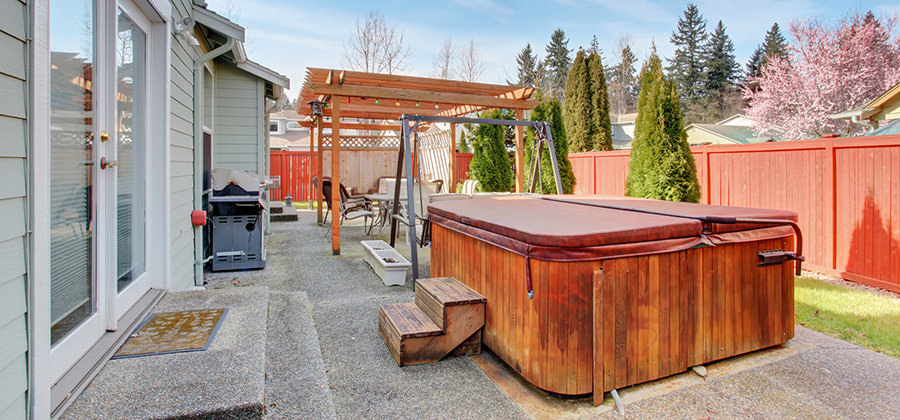
Fixed permanent hot tub structures: A fixed permanent structure will take the most planning but will also offer the best protection from the weather. You might want to just have a gazebo type structure or even go for a more enclosed outbuilding with a full roof on. Remember that once you start building permanent structures in your garden you will need to find out if you need to get planning permission. However, a permanent structure can be well worth it just in terms of making your hot tub more usable all year and providing an added level of privacy and comfort.
Temporary, portable hot tub enclosures: Temporary structures can be put up and down as you need them and also used for other purposes as well. The advantage of a temporary structure is that it will be considerably cheaper than a fixed permamant one but it won’t last as long or give the same amount of protection.
Side Umbrellas: Side umbrellas look stylish and can offer good protection from the sun. You need to make sure that you buy one with a good solid base or, alternatively one that will secure to the side of the hot tub.
Canopies or sails: These are a relatively budget solution but they can look quite cool and give a good level of weather protection. They take a bit of setting up as you need to suspend them from close by buildings or structures but once they are up they are maintenance-free.
Whatever structure you plan on going for you need to plan and measure carefully. Will it fit over the hot tub and allow room for maintenance? Do you want all-weather protection or just shade from the strong midday sun? Do you have to allow for planning considerations or can you put the structure up without planning permission at all? However, one of the most important considerations is how the structure will look. Will it compliment the hot tub and make space look stylish and inviting and how will it blend in with the rest of your garden and garden furnishings?
Getting your hot tub delivered
Once you have decided exactly where your hot tub is going to be situated, prepared the base and made any decisions about whether or not you are going to have any additional building or structure over your hot tub it’s finally time to plan the hot tub’s delivery. If you are buying a new hot tub then delivery will probably be included in the price so the actual physical hard work of moving the hot tub will be done by the supplier. If you are moving a hot tub or buying a secondhand hot tub the best advice is also to get a professional mover to actually physically move it. Hot tubs are extremely heavy and awkward to move around. You really need specialist lifting equipment and also some experience of how to handle them to safely move them from place to place. If you do decide to move a hot tub yourself be aware that the risk of damaging the hot tub is quite high not to mention the risk of actually injuring yourself as well.
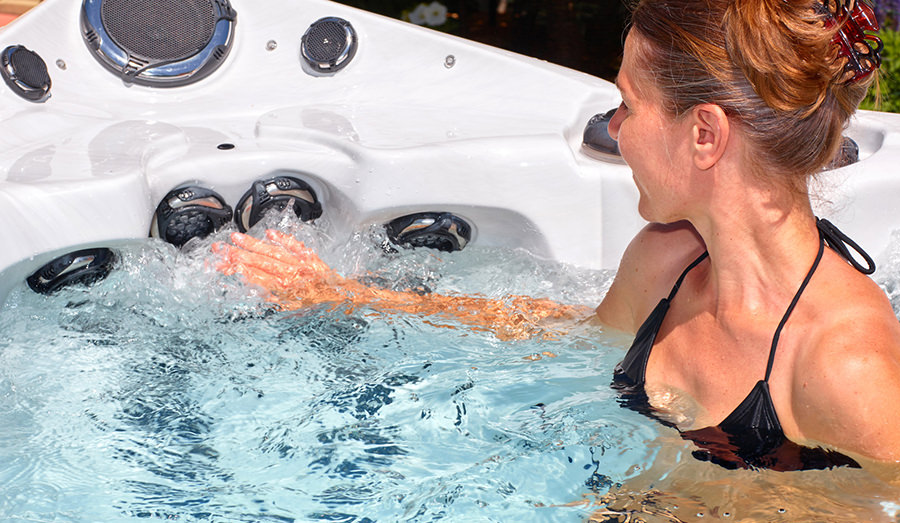
Even if you are having the hot tub delivered you will still need to make some preparations. The main question is as to how the hot tub will be transported from the road into your house or garden. Do you have a wide enough access path? Is the surface of the access path suitable for pushing a wheeled trolley along? Will the hot tub fit around the corner of the house on it’s way into the garden? To answer these questions accurately you need to know that exact dimensions of your hot tub as it will be delivered in it’s protective packaging. It might be that you need to temporarily move a garden gate or possibly take down the garden fence to allow access. You might even only be able to gain access from your neighbor’s garden if space is really tight. The worst-case scenario is that you have a completely enclosed rear garden and that your hot tub will need to be lifted by crane over your house and lowered into position in your garden this way. This is not as unusual as you might think and there are fairly frequent pictures and videos posted on the various hot tub Facebook groups of proud hot tub owners having their new hot tub crane delivered over their house.
The main thing is that you don’t just hope for the best and assume that the delivery people will be able to somehow get your hot tub through tiny spaces and into your back garden. If they arrive and can’t deliver then you will probably have to bear the expense of them taking the hot tub away and redelivering it. Do your measuring and do your homework and make whatever alterations or provision you need to make to ensure that your hot tub can make it into situ!
Final preparations
Finally, you will need to call in an electrician to connect the hot tub to the mains supply. You will need a dedicated outdoor supply and possibly a buried underground cable which then connects directly to the hot tub. With all hot tubs, apart from inflatable ones, do not be tempted to skimp on this or to try to connect the hot tub with a DIY extension cable to a socket inside the house. Water and electricity simply do not make a good combination and the risks are too high.
Before filling your hot tub for the first time it’s really important to give the shell a thorough clean with a specially designed hot tub cleaning solution. You might even want to fill the hot tub with water and then use a flushing solution to clean any debris and dirt from the manufacturing process out.
To do this you need to do the following:
Fill the hot tub with water to it’s normal fill level and then add the flushing solution to the water. Run the jets for 20 minutes or so. This will allow the flushing solution to circulate and flush out any debris into the shell. Drain the water completely and then clean the shell thoroughly with a hot tub cleaning solution. Wash off all of the cleaning solution with clear water.
The idea here is that the inner workings of the hot tub and the hot tub itself should be a clean as possible before your final filling. Any dirt from the manufacturing process or any impurities will potentially impact on the water becoming dirty so the cleaner the hot tub is at the outset the longer the water should last between changes and the fewer chemicals you will need to keep it clean.
Once the hot tub is full of clean fresh water you can then continue the process of getting the PH levels correct and adding the sanitizer. I have a detailed post here which explains all of this and your ongoing maintenance.

